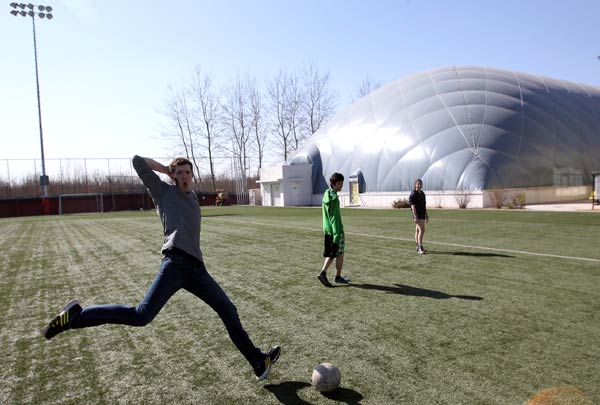

Students at Western Academy of Beijing play soccer near the international school's dome, which is inflated with purified air. The dome was set up in November so that students can exercise on smoggy days. ZHANG WEI / CHINA DAILY
The heavy smog that has shrouded the Beijing-Tianjin-Hebei area for several days eased somewhat on Thursday afternoon, but experts said it won't disperse until Saturday.
Eleven of the 39 cities in the region witnessed an hourly PM2.5 intensity above 150 micrograms per cubic meter on Thursday, according to the Ministry of Environmental Protection.
PM2.5 refers to particulate matter with a diameter smaller than 2.5 micrograms, which can harm people's hearts and lungs and may be linked to cancer.
According to the national standard, an hourly PM2.5 intensity above 75 micrograms per cubic meter indicates polluted air.
Concentrations soared to 339 micrograms per cubic meter in downtown Beijing on Thursday morning, while the southwestern part of the city saw 361 micrograms per cu m, according to the Beijing Environmental Monitoring Center.
Pollutant levels dropped to roughly half that by Thursday afternoon and evening, but remained at unhealthy levels.
Cold air can be expected over the weekend, when most of Beijing and the neighboring areas will have favorable weather that will diffuse the pollutants, according to the municipal meteorological center.
The Beijing Environmental Protection Bureau issued a yellow smog warning on Thursday, suggesting that the capital's schools and kindergartens suspend outdoor exercises and urging heavily polluting enterprises to cease operations. It also urged residents to use public transportation.
The city government sent out batches of law enforcement officers to monitor construction sites and illegal outdoor barbecues.
Ma Jun, director of the Institute of Public and Environmental Affairs, said that in addition to releasing general warnings about pollutant intensity, the government should measure real-time emissions of the major polluting enterprises.
Despite recent weather conditions that hinder smog dispersal, the suspension or reduction of production at some enterprises might mitigate the pollution, Ma said, adding that government should provide strict supervision.
The educational authorities should also carry out the experts' recommendation to suspend outdoor activities to ensure children's health, he said.
Lin Xiang, the mother of an 8-year-old boy in Beijing, said she bought various masks for her family to protect against inhalation of dirty air and was especially worried about her son.
"Primary schools should consider suspending classes during days like this," she said. "The educational authorities should consider distance education when it's like this."
The smog has also extended to the eastern and central regions of China, including Shandong and Hubei provinces. They saw parts of their expressways closed over the past two days.
The lingering smog has seriously reduced visibility in Liaoning province, and the province has closed 13 highways. Visibility was reportedly at only 50 to 60 meters in some places.
More than 10 flights were delayed on Thursday morning at Shenyang Taoxian International Airport.
China's meteorological administration issued a yellow smog warning nationwide on Thursday morning, forecasting that the serious smog will linger in the Beijing-Tianjin-Hebei region, Shandong province, and Liaoning province until Friday night.
Friday's coming cold air will help disperse the smog late in the day, with dispersal expected regionally by Saturday night, said Zhang Tao, chief weatherman of the administration.
Copyright ©1999-2018
Chinanews.com. All rights reserved.
Reproduction in whole or in part without permission is prohibited.